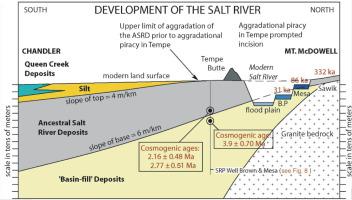当前位置:
X-MOL 学术
›
Geomorphology
›
论文详情
Our official English website, www.x-mol.net, welcomes your
feedback! (Note: you will need to create a separate account there.)
Drainage integration of the Salt and Verde rivers in a Basin and Range extensional landscape, central Arizona, USA
Geomorphology ( IF 3.1 ) Pub Date : 2021-02-01 , DOI: 10.1016/j.geomorph.2020.107512 Steve J. Skotnicki , Yeong B. Seong , Ronald I. Dorn , Phillip H. Larson , Jersy DePonty , Ara Jeong
Geomorphology ( IF 3.1 ) Pub Date : 2021-02-01 , DOI: 10.1016/j.geomorph.2020.107512 Steve J. Skotnicki , Yeong B. Seong , Ronald I. Dorn , Phillip H. Larson , Jersy DePonty , Ara Jeong

|
Abstract The Salt River and Verde River watersheds provide downstream metropolitan Phoenix, Arizona, USA with much of its water supply, and this paper explains how these rivers integrated in an extensional tectonic setting. Near the end of the Pliocene, segments of the proto-Salt and proto-Verde watersheds of central Arizona consisted of local drainage networks supplying water and sediment into internally drained basins, including depressions occupied by late Pliocene natural lakes occupying the Verde Valley and Tonto basins. A key location, the lower Verde River valley (LVRV), is where the modern-day drainages of the Salt and Verde now meet downstream of these Pliocene lakes. At the time of the Nomlaki tuff deposition ~3.3 Ma, a condition of sediment overfill existed in the LVRV, although there was no exoreic drainage and a playa was still maintained. A fanglomerate unit, named here the Rolls formation, spilled over a bedrock sill and an alluvial-fan ramp transported sediment into the Higley Basin that underlies the eastern part of metropolitan Phoenix. Lithologies of preserved remnants of this Pliocene alluvial-fan system match well cuttings of buried sediment in the Higley Basin with a cosmogenic burial isochron age of 3.90 ± 0.70 Ma. Based on cosmogenic burial isochron ages, ancestral Salt River gravels started depositing on top of this fan ramp between 2.8 and 2.2 Ma. Deposition of Salt and Verde river gravels in the Higley Basin continued for ~ 2 million years and eventually led to an aggradational piracy event that overtopped a bedrock ridge immediately east of Phoenix’s Sky Harbor Airport. A cosmogenic burial age of 460 ± 23 ka is a rough maximum age for this river avulsion that relocated the Salt River into the Luke Basin that underlies western metropolitan Phoenix. Available chronometric data are not precise enough to determine whether the Salt River or Gila River integrated first. All of the exoreic rivers of western North America’s Basin and Range Province — the lower Colorado, Gila, Rio Grande, Salt, and Verde rivers — employed lake overflow to integrate across half-graben, graben, rift and supradetachment tectonic settings.
中文翻译:

美国亚利桑那州中部盆地和山脉伸展景观中盐河和佛得河的排水整合
摘要 Salt River 和 Verde River 流域为下游美国亚利桑那州凤凰城提供了大部分供水,本文解释了这些河流如何在伸展构造环境中整合。在上新世末期,亚利桑那州中部原始盐分和原始佛得角流域的部分由当地排水网络组成,将水和沉积物供应到内部排水盆地,包括由占据佛得谷和通托盆地的上新世晚期天然湖泊所占据的洼地. 一个关键位置,即较低的佛得河谷 (LVRV),是盐湖和佛得河的现代排水现在在这些上新世湖泊下游汇合的地方。在Nomlaki凝灰岩沉积~3.3 Ma时,LVRV中存在沉积物溢流状态,尽管没有外流排水并且仍然保持着一个海滩。一个在这里命名为 Rolls 地层的 fanglomerate 单元溢出了基岩基石和冲积扇坡道,将沉积物输送到位于凤凰城东部的希格利盆地。这个上新世冲积扇系统保存下来的残余岩性与 Higley 盆地埋藏沉积物的井切屑相匹配,其宇宙成因埋藏等时线年龄为 3.90 ± 0.70 Ma。根据宇宙成因埋藏等时线年龄,祖先盐河砾石在 2.8 到 2.2 Ma 之间开始沉积在这个扇形斜坡的顶部。盐和佛得角河砾石在 Higley 盆地的沉积持续了大约 200 万年,最终导致了一次加剧的海盗事件,该事件越过了凤凰城天港机场以东的基岩山脊。460 ± 23 ka 的宇宙成因埋藏年龄是这条河流撕裂的粗略最大年龄,将盐河重新安置到位于凤凰城西部大都市之下的卢克盆地。可用的计时数据不够精确,无法确定是盐河还是吉拉河先整合。北美西部盆地和山脉省的所有外流河流——科罗拉多河下游、希拉河、里奥格兰德河、盐河和佛得角河——都利用湖泊溢流来整合半地堑、地堑、裂谷和超分离构造环境。
更新日期:2021-02-01
中文翻译:

美国亚利桑那州中部盆地和山脉伸展景观中盐河和佛得河的排水整合
摘要 Salt River 和 Verde River 流域为下游美国亚利桑那州凤凰城提供了大部分供水,本文解释了这些河流如何在伸展构造环境中整合。在上新世末期,亚利桑那州中部原始盐分和原始佛得角流域的部分由当地排水网络组成,将水和沉积物供应到内部排水盆地,包括由占据佛得谷和通托盆地的上新世晚期天然湖泊所占据的洼地. 一个关键位置,即较低的佛得河谷 (LVRV),是盐湖和佛得河的现代排水现在在这些上新世湖泊下游汇合的地方。在Nomlaki凝灰岩沉积~3.3 Ma时,LVRV中存在沉积物溢流状态,尽管没有外流排水并且仍然保持着一个海滩。一个在这里命名为 Rolls 地层的 fanglomerate 单元溢出了基岩基石和冲积扇坡道,将沉积物输送到位于凤凰城东部的希格利盆地。这个上新世冲积扇系统保存下来的残余岩性与 Higley 盆地埋藏沉积物的井切屑相匹配,其宇宙成因埋藏等时线年龄为 3.90 ± 0.70 Ma。根据宇宙成因埋藏等时线年龄,祖先盐河砾石在 2.8 到 2.2 Ma 之间开始沉积在这个扇形斜坡的顶部。盐和佛得角河砾石在 Higley 盆地的沉积持续了大约 200 万年,最终导致了一次加剧的海盗事件,该事件越过了凤凰城天港机场以东的基岩山脊。460 ± 23 ka 的宇宙成因埋藏年龄是这条河流撕裂的粗略最大年龄,将盐河重新安置到位于凤凰城西部大都市之下的卢克盆地。可用的计时数据不够精确,无法确定是盐河还是吉拉河先整合。北美西部盆地和山脉省的所有外流河流——科罗拉多河下游、希拉河、里奥格兰德河、盐河和佛得角河——都利用湖泊溢流来整合半地堑、地堑、裂谷和超分离构造环境。











































 京公网安备 11010802027423号
京公网安备 11010802027423号